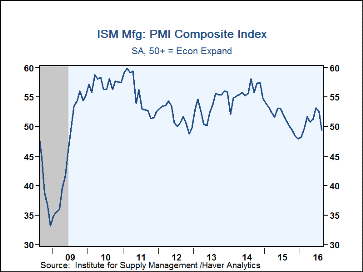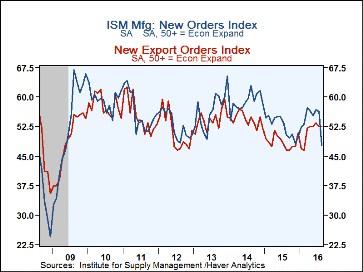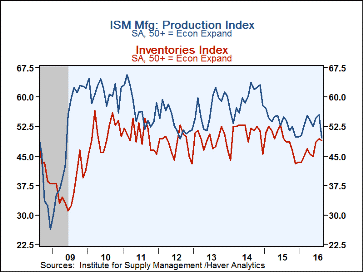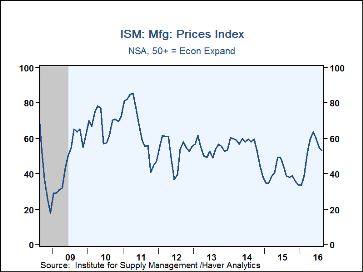 Global| Sep 01 2016
Global| Sep 01 2016ISM Manufacturing Index Declines; Prices Paid Index Weakens
by:Tom Moeller
|in:Economy in Brief
Summary
Contraction in the level of factory sector activity has recurred. The ISM Composite Index of manufacturing activity fell to 49.4 during August from an unrevised 52.6 in July. It was the lowest level since January, and compared to 52.0 [...]
Contraction in the level of factory sector activity has recurred. The ISM Composite Index of manufacturing activity fell to 49.4 during August from an unrevised 52.6 in July. It was the lowest level since January, and compared to 52.0 expected in the Action Economics Forecast Survey. The decline left the average for the first eight months this year at 50.9, down from 51.3 averaged in 2015. During the last ten years, there has been a 75% correlation between the index level and the q/q change in real GDP.
Declines in the component readings were all-inclusive. New orders & production fell m/m, and indicated contraction for the first time since December. The employment index declined further below break-even, where it's been in all but one month this year. During the last ten years, there has been an 88% correlation between the index level and the m/m change in factory sector payrolls. The decline in the supplier deliveries index to 50.9 suggested the quickest product delivery speeds since April. The inventories index moved slightly lower to 49.0, but remained up versus its weakest reading nine months ago.
The separate prices paid figure fell to 53.0, its weakest reading since March. It was down from a high of 63.5 three months ago. Nineteen percent (NSA) of respondents reported paying higher prices while 13 percent paid less.
Amongst the other ISM series, the export index held steady at 52.5, remaining up versus the February low of 46.5. The imports index fell sharply to 47.0, its lowest level since December. The order backlog index fell to 45.5, its lowest reading since January.
The ISM figures are diffusion indexes where a reading above 50 indicates increase. The figures from the Institute for Supply Management can be found in Haver's USECON database. The expectations number is in Haver's AS1REPNA database.
| ISM Mfg (SA) | Aug | Jul | Jun | Aug '15 | 2015 | 2014 | 2013 |
|---|---|---|---|---|---|---|---|
| Composite Index | 49.4 | 52.6 | 53.2 | 51.0 | 51.3 | 55.6 | 53.8 |
| New Orders | 49.1 | 56.9 | 57.0 | 51.7 | 52.6 | 58.9 | 56.8 |
| Production | 49.6 | 55.4 | 54.7 | 54.0 | 53.5 | 59.2 | 57.5 |
| Employment | 48.3 | 49.4 | 50.4 | 50.5 | 51.0 | 54.4 | 53.1 |
| Supplier Deliveries | 50.9 | 51.8 | 55.4 | 50.4 | 50.7 | 55.0 | 51.9 |
| Inventories | 49.0 | 49.5 | 48.5 | 48.5 | 49.0 | 50.8 | 49.4 |
| Prices Paid Index (NSA) | 53.0 | 55.0 | 60.5 | 39.0 | 39.8 | 55.6 | 53.8 |
Tom Moeller
AuthorMore in Author Profile »Prior to joining Haver Analytics in 2000, Mr. Moeller worked as the Economist at Chancellor Capital Management from 1985 to 1999. There, he developed comprehensive economic forecasts and interpreted economic data for equity and fixed income portfolio managers. Also at Chancellor, Mr. Moeller worked as an equity analyst and was responsible for researching and rating companies in the economically sensitive automobile and housing industries for investment in Chancellor’s equity portfolio. Prior to joining Chancellor, Mr. Moeller was an Economist at Citibank from 1979 to 1984. He also analyzed pricing behavior in the metals industry for the Council on Wage and Price Stability in Washington, D.C. In 1999, Mr. Moeller received the award for most accurate forecast from the Forecasters' Club of New York. From 1990 to 1992 he was President of the New York Association for Business Economists. Mr. Moeller earned an M.B.A. in Finance from Fordham University, where he graduated in 1987. He holds a Bachelor of Arts in Economics from George Washington University.










